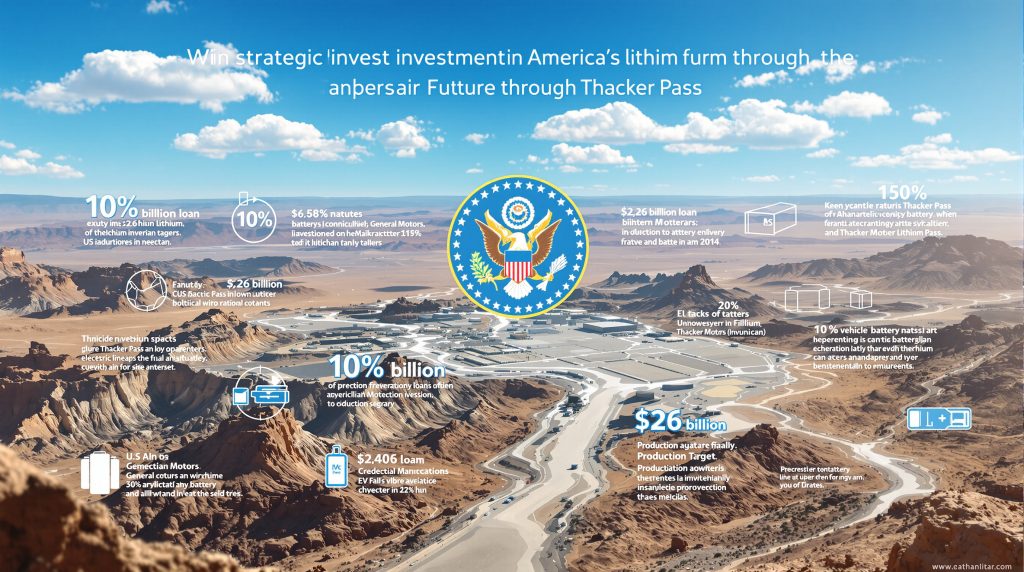How is the US Government Investing in Domestic Lithium Production?
The US government stake in Thacker Pass lithium project drives a renewed focus on domestic resource security. The US government’s drive to secure critical mineral supplies is entering a new phase with its pursuit of up to a 10% equity stake in Lithium Americas’ Thacker Pass lithium project. Furthermore, this marks an evolution from reliance on loan guarantees to direct asset ownership.
In addition, the Department of Energy already provided a $2.26 billion loan to support the project’s development in Nevada. Meanwhile, federal officials are negotiating this deal while considering market pressures from depressed global lithium prices.
Why is the Thacker Pass Project Strategically Important?
The Cornerstone of US Lithium Independence
Located 25 miles south of the Nevada-Oregon border, the Thacker Pass project sits at the heart of US ambitions. Expected to become the largest lithium producer in the region by 2028, this development paves the way for a transformative step-change in sourcing essential battery materials domestically.
For instance, advanced lithium mining techniques are being evaluated to boost production capacities further. This project not only meets growing domestic demand but also underpins broader economic ambitions.
Current and Projected Lithium Production:
- Annual lithium production: <5,000 tonnes (current US total) versus 40,000 tonnes at Thacker Pass (Phase 1).
- Ranking: Currently not leading in the Western Hemisphere compared with the projected largest output by 2028.
This dramatic increase from less than 5,000 tonnes to 40,000 tonnes emphasises the project’s strategic significance.
Breaking the Dependency Cycle
By establishing a secure, domestic source of lithium, Thacker Pass aims to dramatically shrink US reliance on foreign sources, especially from China. Consequently, it will fortify national security by ensuring resource sovereignty. In addition, it supports the burgeoning US electric vehicle (EV) and energy storage sectors.
Key objectives include:
- Reducing import reliance with advanced lithium batteries revolution.
- Fostering resilient domestic supply chains.
- Supporting manufacturing expansion in batteries and clean technologies.
Such measures intend to futureproof the economy through a more sustainable resource base.
What Are the Terms of the Government's Proposed Investment?
Equity Stake Negotiations
The federal government’s desired 10% equity stake in Lithium Americas is at the core of ongoing restructuring talks. These discussions have emerged amid economic pressures arising from an oversupplied lithium market and the need for increased US production.
Key elements of the proposal include:
- Issuance of no-cost warrants for 5-10% of shares.
- Securing federal equity without direct upfront capital.
- Adjusting loan terms in response to low lithium prices that threaten project economics.
Additionally, the market’s volatility further substantiates the need for a robust US mineral production order. Discussions with General Motors are also underway to integrate broader federal controls into project oversight.
Key Loan Restructuring Considerations:
- Lithium price volatility necessitates flexible repayment.
- Dominance by foreign suppliers, particularly China, heightens the need for domestic control.
- Adaptive financial structures become essential with evolving economic conditions.
- Increased oversight aligns with critical security objectives.
Such reassessments ensure that project financing remains viable even under fluctuating market conditions.
Who Are the Key Stakeholders in the Thacker Pass Project?
Ownership Structure and Commercial Agreements
Thacker Pass is characterised by its complex stakeholder network. The major partners include:
- Lithium Americas: Holding a controlling 62% stake.
- General Motors: With a $625 million investment securing a 38% share and long-term purchase rights.
- US Department of Energy: Supplier of the $2.26 billion loan; currently negotiating for equity.
- Federal Government: Pursuing operational influence through direct stake holdings and control over offtake commitments.
GM’s Offtake Rights
Federal stakeholders underscore the importance of maintaining GM’s commitment to supply agreements. Specific features include:
- Secured rights to purchase all lithium from the project’s initial production phase.
- Acquisition rights that extend into subsequent phases.
- A long-term (20-year) contract ensuring consistent supply for battery and EV manufacturing.
These arrangements are designed to ensure that public interests remain central to the project’s success.
How Does This Investment Compare to Other Government Resource Initiatives?
The pursuit of an equity stake reflects a wider trend toward direct investment in industries crucial to national security and technological leadership. For instance, federal involvement in semiconductor and rare earth mining projects has paved the way for more proactive resource management.
Recent interventions such as investments in:
- Semiconductors (Intel): To maintain robust domestic chip manufacturing.
- Rare Earths Mining (MP Materials): Backed with funding and offtake agreements.
Furthermore, this strategy mirrors a gradual shift defined by Trump’s critical minerals order, moving away from passive policies towards active government engagement.
An increasing number of analysts point to a direct correlation between such strategies and long-term national success. In addition, a recent Reuters report highlights the evolving landscape of government participation in resource projects.
What Challenges Does the Thacker Pass Project Face?
While Thacker Pass holds transformative potential, it is not without significant challenges.
Market and Economic Hurdles:
- Lithium price volatility: Driven by Chinese overproduction and global demand shifts, creating financing strains.
- High capital intensity: Requires sustained, long-term investment.
- Commodity price risk: Particularly significant during the early operational stages.
Technical and Regulatory Barriers:
- Complex regulatory and permitting environments demand close coordination with local, state, and federal agencies.
- Environmental and community engagement presents challenges, especially given the sensitive ecological region.
- A specialised workforce is needed to support novel lithium extraction and processing technologies.
- Infrastructure development in rural areas poses additional challenges.
Project Risk Overview:
- Lithium price depression: High risk with financial hedging as mitigation.
- Regulatory approvals: Moderate risk requiring early stakeholder engagement.
- Infrastructure complexity: Moderate risk mitigated by public-private partnerships.
- Community/environmental opposition: Moderate risk managed through transparent consultation.
These hurdles necessitate a proactive approach to overcoming both economic and technical obstacles.
How Might Government Involvement Impact Project Development?
Potential Benefits of Federal Partnership
Federal participation introduces several distinct advantages:
- Enhanced project credibility with investors and local communities.
- Streamlined regulatory pathways due to unified government backing.
- Access to additional technical, financial, and human resources.
- A strong international signal of the US commitment to battery and EV supply chain security.
Operational Considerations
However, direct government involvement brings its own set of requirements:
- Influence on day-to-day operational decisions might be increased.
- Compliance and reporting mandates become more stringent.
- There is a continuous need to align project outcomes with public policy, which may sometimes conflict with private profit motives.
- Balancing public benefit with the agility demanded by commodity markets remains critical.
Such advantages and challenges must be weighed to determine overall project viability.
What Does This Mean for the US Battery Supply Chain?
Transforming Domestic Production Capacity
The successful development of Thacker Pass could radically alter the domestic battery supply chain. The first phase’s 40,000-tonne annual capacity is expected to surpass current US output by a significant margin.
Key impacts include:
- Direct supply of lithium feedstock to multiple US gigafactories.
- Strengthened domestic supply chains which reduce geopolitical risks.
- Maturation of ancillary industries, including battery recycling and advanced materials processing.
Moreover, these changes are likely to foster a notable critical minerals energy security environment, further bolstering domestic production capabilities.
Broader Economic Implications
Federal equity in Thacker Pass signifies:
- A robust US commitment to developing a domestic clean energy ecosystem.
- The creation of high-skilled jobs in extraction, processing, and manufacturing.
- An acceleration of EV adoption and grid-scale storage facilitated by cheaper, stable material inputs.
- Attraction of downstream investment in cathode, anode, and cell manufacturing sectors.
With robust operational initiatives, phenomenal growth awaits the US battery sector.
What’s Next for the Thacker Pass Project?
Near-Term Milestones
Over the coming quarters, several critical events will shape the future of the US government stake in Thacker Pass lithium project. These include:
- Finalisation of equity stake terms and review of shareholding structure.
- Agreement on restructured Department of Energy loan mechanisms.
- Acceleration of site development and infrastructure projects.
- Clarity on production schedule and target ramp-up dates.
In addition, ongoing discussions point to increased collaboration with private sector partners. A recent CNBC analysis highlights these imminent developments.
Long-Term Strategic Positioning
Long-term success hinges on:
- Achieving or exceeding production benchmarks.
- Innovating processing and refining techniques to meet battery-grade standards.
- Seamlessly connecting extraction with downstream battery and EV manufacturing.
- Managing potential future volatility in mineral prices and shifting supply chain demands.
Such a framework is necessary for realising the project’s full potential.
What Does This Signal About US Critical Minerals Policy?
The direct pursuit of an equity stake in Thacker Pass reveals a decisive pivot in US resource policy. This move underlines a clear commitment to safeguarding domestic supply chains through increased government intervention.
In addition, it reflects a broader strategy of active ownership and control. As a result, there is growing emphasis on factors such as strategic industrial reshoring and sustainable policy frameworks. Such initiatives reinforce the importance of the US government stake in Thacker Pass lithium project and ensure that projects align with national interests.
FAQs About the US Government Stake in Thacker Pass Lithium Project
Q: Why is the US government seeking an equity stake rather than just providing loans?
A: Holding equity ensures long-term influence over the project’s direction while aligning its goals with national interests. Moreover, it mitigates loan repayment risks under volatile market conditions.
Q: How does this investment affect lithium prices for consumers?
A: Although the investment does not immediately impact market prices, increased domestic production capacity could, over time, stabilise or reduce prices for battery manufacturers and consumers alike.
Q: Will government involvement speed up project development?
A: Federal backing has the potential to reduce regulatory delays by mobilising additional resources. However, project timelines remain subject to technical, environmental, and commercial challenges.
Q: How does this compare to China’s approach to critical minerals?
A: While the US approach is more measured than China’s state-directed strategy, direct equity participation in projects like Thacker Pass marks a historic shift towards proactive resource management.
“The move represents a paradigm shift in how governments engage with critical resources,” experts have observed.
Are You Ready to Seize the Next Big Mineral Discovery?
Powered by the proprietary Discovery IQ model, Discovery Alert offers real-time alerts that could be the game-changer for your investment strategies. Visit the Discovery Alert Discoveries page to explore how historic discoveries have led to exceptional returns, and start your 30-day free trial today to gain a competitive edge in the market.




